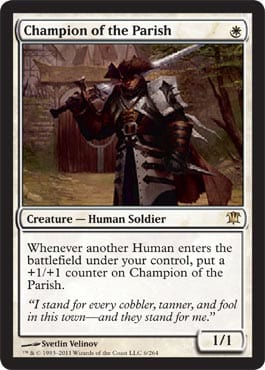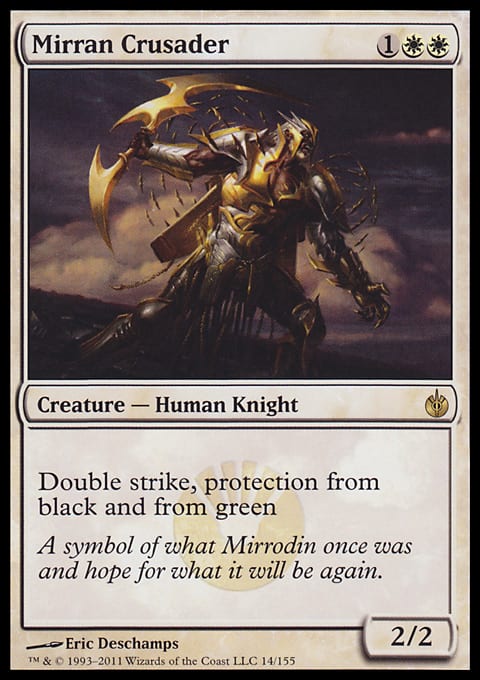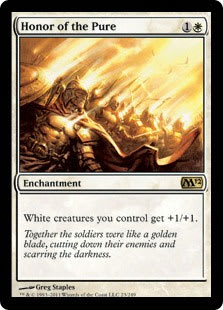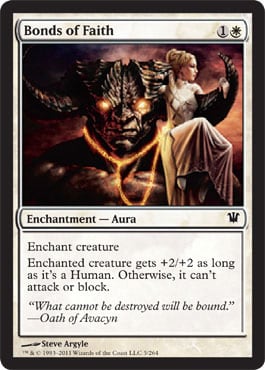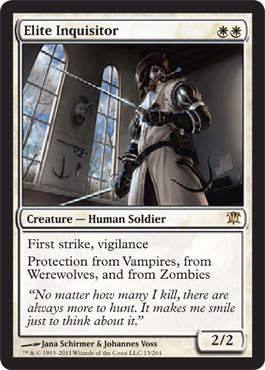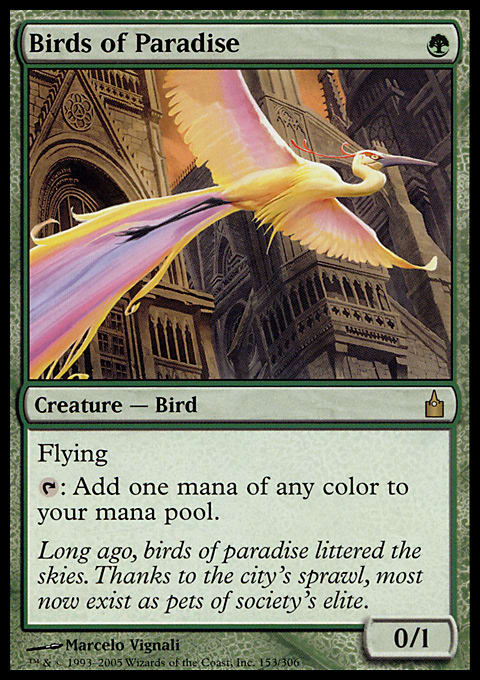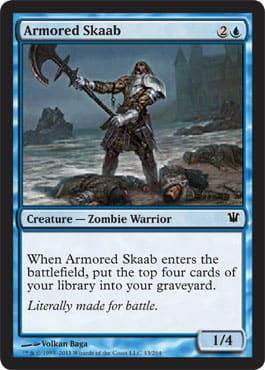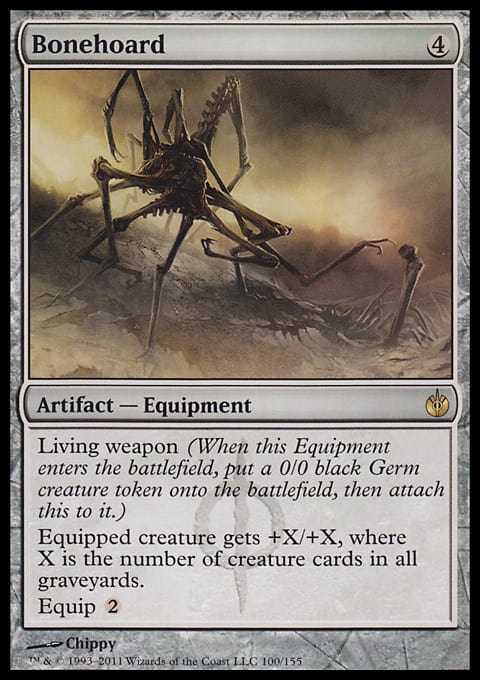In my last article, we looked at what appeared to be the first bump in the road for Event Decks in their inaugural year, 2011. Designed to be gateways to Standard play, Wizards of the Coast looked to balance playability with reprint concerns, and come up with something that was both useful and appealing, but didn’t unduly take demand away from their core products.
The search for powerful cards that would serve as a draw for consumers started to shift to older sets that were still in Standard, notably cards like Stoneforge Mystic and Verdant Catacombs. But Magic 2012’s Vampire Onslaught proved to push that idea a little too far, as it was Standard-legal for only a few months.
Little surprise, then, that the very next set — Innistrad — came with a pair of Event Deck offerings that had the shelf lives of Twinkies.
Year: 2011
Set: Innistrad
Deck: Hold the Line
Rares: Champion of the Parish, Elite Inquisitor, Honor of the Pure (x2), Mirran Crusader (x2), Nevermore
Hold the Line ? Innistrad Event Deck| Wizards of the Coast
- Creatures (22)
- 1 Champion of the Parish
- 1 Elite Inquisitor
- 2 Elite Vanguard
- 2 Mirran Crusader
- 4 Accorder Paladin
- 4 Doomed Traveler
- 4 Fiend Hunter
- 4 Gideon's Lawkeeper
- Enchantments (10)
- 2 Honor of the Pure
- 4 Bonds of Faith
- 4 Oblivion Ring
- Artifacts (4)
- 2 Butcher's Cleaver
- 2 Silver-Inlaid Dagger
- Lands (24)
- 24 Plains
Less than half a year earlier, with May’s New Phyrexia, Wizards of the Coast had given us a Mono-White deck in War of Attrition. As far as deck archetypes go, Mono-White decks tend to feature aggressive, cheap creature swarms in an archetype known as “White Weenie.” War of Attrition was little different. The highest converted mana cost (CMC) of any creature in the deck was a mere three, and with twenty-three creatures in the deck you were seldom at a loss to keep offensive pressure on.
Of course, War of Attrition was very much a creature of its time. Appearing in New Phyrexia, it contained nine different artifacts — all of them Equipment, and most of those with living weapon. Those same tools would be creatures themselves when they entered the battlefield, making this deck fully half creatures (30 out of 60; 32 if you then count the Dread Statuary).
Hold the Line, as the name implies, takes a somewhat less aggressive posture. You still have a sizable core of creatures, and even a sprinkling of Equipment. But in return for dialing down the creature density, it offers twice the amount of enchantment-based removal (playsets of Bonds of Faith and Oblivion Ring, against 4 Journey to Nowhere). There’s also a pair of Honor of the Pure to give your team an immediate boost in force projection.
Just as before, the creature suite is lean in cost, with no creatures costing more than 3 mana. Ideally, you’d want to drop 1-, 2-, and 3-drops on your first three turns, then a pair of 2-drops on turn four. This is especially true if that opening 1-drop happens to be the Champion of the Parish, a very strong opener that taps into the tribal Human element present in Innistrad. Elite Vanguard — the modern-day Savannah Lion — makes a solid option, with Doomed Traveler available as well. Gideon's Lawkeeper offers some board control, and unlike many 1-drop creatures in Magic, they’re often even better to draw later in the game.
For 2-drops, you get a playset of Accorder Paladins, and an Elite Inquisitor. The Inquisitor is a rare, and packs quite a bit of utility in with the flavor. Sure you might not expect to face Vampires, Werewolves, or Zombies every game, but they’re out there. And the first strike and vigilance make it an excellent card even when you don’t. The Paladins, with the battle cry mechanic from Mirrodin Besieged, are another way to let your army punch above its weight.
Finally, for the 3-drops, you get another dose of removal with the Fiend Hunters, and a pair of Mirran Crusaders. The Crusaders fall into the category we’ve discussed before, which are money cards that are from an older Standard-legal set, and therefore safe reprints for a Preconstructed product. The Hunters, meanwhile, highlight an interesting different in tactics from War of Attrition. Both decks share the same fundamental strategy — White Weenie — but both take markedly different approaches.
War of Attrition was as straightforward a swarm deck as they come. Nearly everything you drew that wasn’t land was a creature, and your main objective was to overwhelm your opponent through strength of numbers. In a sense, this wasn’t unlike the (generally mythologized) Russian “tactic” of sending two men into battle with one rifle in World War II. Your horde goes screaming across the red zone, and when your Flayer Husk goes down, a nearby Elite Vanguard grabs him and jams him on. You could afford the losses, because you’d be drawing into new creatures almost as fast as you could play them. A war of attrition, indeed!
Hold the Line takes a much more tactical approach. Although like all White Weenie decks you can often expect to take a high rate of loss, you have a lot more tools at your disposal to protect your creatures from harm. The Bonds of Faith pull double-duty, able to buff your creatures instead of being removal as every one of them is a Human. This falls prey to the typical vulnerabilities of creature enhancements, but it’s always good to have the option. With triple the amount of removal, this deck’s creatures may live a (comparatively) charmed life.
As for the sideboard, Leonin Relic-Hoarders do for artifacts and enchantments what the Fiend Hunter does for creatures, while the Suture Priest is a hedge against creature-heavy opposition. You have some color-hosing against Red and/or Black decks with Celestial Purge, and a bit of graveyard hate thanks to the Nihil Spellbomb. Finally, as a one-of magic bullet against virtually any other card you can face, you get a miser’s copy of Nevermore.
Overall, it wasn’t surprising to see this archetype reappear. As we’ve pointed out before, when you’re working on a budget, speed can work to your advantage much better than control. The more time you give your opponent, the more the strength of their deck will pull ahead of yours. A swift and overwhelming start with Hold the Line can overcome most any deck — though in fairness, the deck would often need both a strong start and a stumble from the opponent.
Year: 2011
Set: Innistrad
Deck: Deathfed
Rares: Birds of Paradise, Bonehoard (x2), Green Sun's Zenith, Hinterland Harbor, Ratchet Bomb, Splinterfright
Deathfed ? Innistrad Event Deck| Wizards of the Coast
- Creatures (21)
- 1 Birds of Paradise
- 1 Splinterfright
- 2 Acidic Slime
- 2 Merfolk Looter
- 3 Viridian Emissary
- 4 Armored Skaab
- 4 Boneyard Wurm
- 4 Llanowar Elves
- Instants (5)
- 1 Gnaw to the Bone
- 4 Forbidden Alchemy
- Sorceries (7)
- 1 Green Sun's Zenith
- 2 Spider Spawning
- 4 Mulch
- Artifacts (3)
- 1 Ratchet Bomb
- 2 Bonehoard
- Lands (24)
- 13 Forest
- 3 Swamp
- 7 Island
- 1 Hinterland Harbor
It’s no surprise that in a deck with a heavy graveyard theme, you find a graveyard-based deck. The central premise of Deathfed was fairly straightforward. First, spend the early game filling your graveyard, and defending yourself through blockers to stall out the game. Then in the later-game, start deploying cards that reward you for how successfully you’ve managed to do just that.
This made Deathfed something of a first. It’s not exactly what you’d call a “combo” deck, but the unconventional way of approaching the game set it apart from the other Event Decks to this point. Those tended to focus on a more straightforward approach. Sure, that approach could be poison-flavored or Vampire-flavored or artifact-flavored, but they were largely variations on a theme. Deathfed asked you to play an entirely two-part game.
For the first part, the deck’s all-star card is the simple Armored Skaab. This card does everything the early stages of this deck wants, both by “stocking the pantry” with four cards, and providing a significant defensive body at a decent price. Here’s the ideal time to play Mulch and Forbidden Alchemy as well, throwing as many cards into the graveyard as possible. Even the Merfolk Looter pulls double-duty here, improving your hand quality and turning a drawback (discarding a card) into an advantage.
Meanwhile, thanks to Birds of Paradise and Llanowar Elves, you should be pulling past your mana curve, while Viridian Emissary is another synergy card that does two things at once (trades out for an attacker and ramps your mana base).
And the payoff? Bigger Bonehoards and Boneyard Wurms. Sizable Splinterfrights and Spider Spawnings. Go wide or go over the top, if you managed to fill up your graveyard, here’s where all of that effort turns into force projection. And if you’ve taken some cuts and scrapes along the way, relief is just a Gnaw to the Bone away.
As for a sideboard, Wizards again offered a broad swath of potential answers at the expense of depth against a more select few. Two more Gnaw to the Bones were good against aggro decks, as lifegain tends to be. Naturalize give some targeted removal against artifacts or enchantments, while Mind Control was well-positioned to deal with decks that relied on fewer, bigger closers. Negates offer a bit of countermagic support, and Flashfreeze some color hate.
Overall, the deck worked reasonably well, but could still be overwhelmed at higher levels of play. It had a much higher degree of non-interactivity than its predecessors, however, which made it both novel as well as perhaps appealing to a narrower market.
Although, as we know now, the Event Deck was a doomed product line, it did carry on for some time after 2011. But the lessons Wizards of the Coast learned from the initial launch would be seen in future releases, as they attempted to adjust the formula time and again to see what would stick.
I hope you’ve enjoyed our look back at the Event Decks of 2011 over the past few articles. I’ll be taking a break from Event Decks for awhile, there’s so much else to explore. And with Amonkhet right around the corner, we’ll have some new reviews and Meddlings coming up too!
















